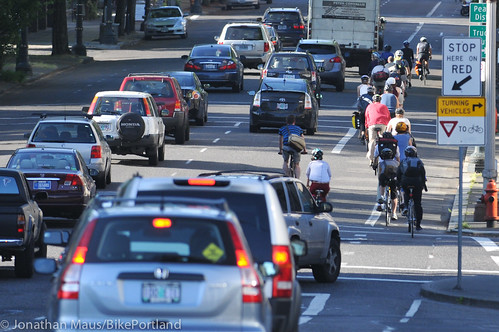
(Photos by J. Maus/BikePortland)
What a difference a few days can make.
On October 8th I tweeted with glee at how a Portland Water Bureau crew maintained a dedicated bicycle lane on NW Broadway and Hoyt during a major sidewalk construction project.
Now THAT is how u do a construction zone.. Thank u @portlandwater ! pic.twitter.com/xvzNXpZz72
— BikePortland (@BikePortland) October 8, 2014
Unfortunately, today that temporary bikeway is completely gone. Instead, there are two standard lanes with nothing more than “Bicycles in Roadway” and “Bike lane closed” signage a half-block prior to the intersection. Here’s the very unfortunate situation that exists now:
Advertisement
What happened?
As we pointed out last year, this section of Broadway sees some of the highest volumes of bicycle traffic anywhere in the city. In fact, there was so much bicycle congestion here that the Bureau of Transportation redesigned the bikeway to make it wider.
So, to have a city crew come in and create a situation where there’s zero dedicated space for bicycles is a bit troubling — especially after initially getting it right.
It seems clear that this is just another example of how the city needs more stringent standards for how construction crews sign their project zones. It should be spelled out clearly on all project permits that if a dedicated bicycle route exists, the project must maintain an equal or greater level of access, or a fully-signed and reasonable detour should be implemented. Failure to do this should result in fines and/or a revocation of the permit until bicycle access is restored. That seems like a reasonable approach from a city transportation department whose leader is committed to Vision Zero.
At last check, the BTA was looking into this issue. With all the construction going on in this town, hopefully it’s still on their radar, and hopefully PBOT and other agencies that work on our streets are paying attention.

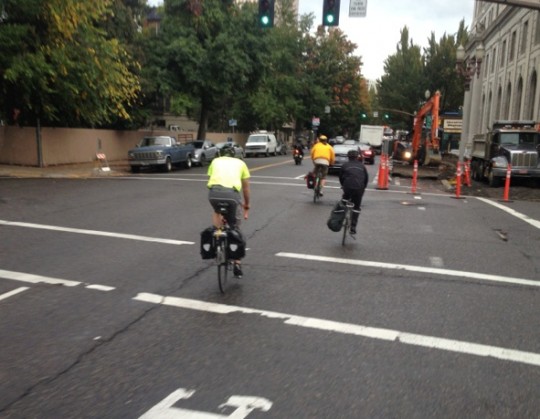
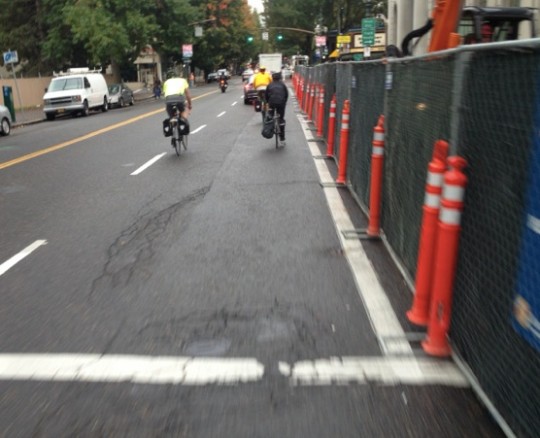
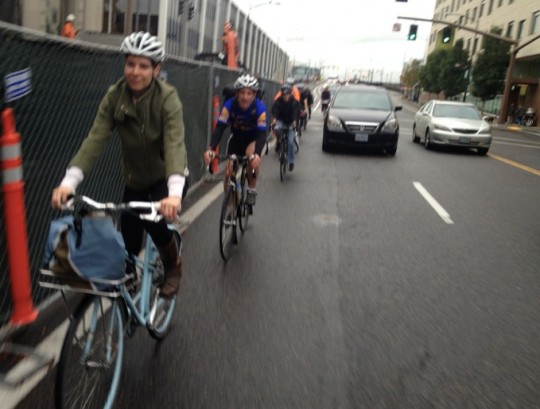
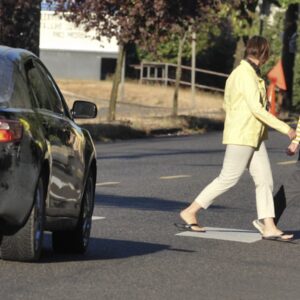
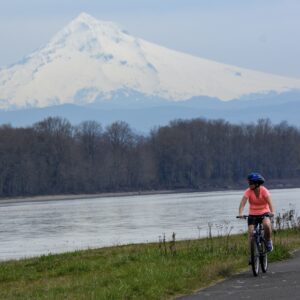
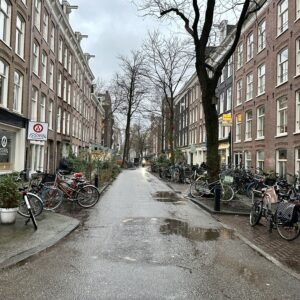
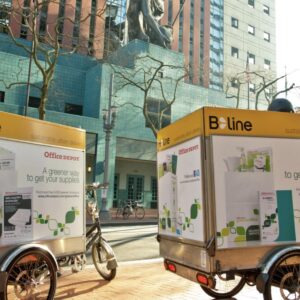
Thanks for reading.
BikePortland has served this community with independent community journalism since 2005. We rely on subscriptions from readers like you to survive. Your financial support is vital in keeping this valuable resource alive and well.
Please subscribe today to strengthen and expand our work.
As bad as this is, I think it is equally as bad that the city allows sidewalks to be completely closed for construction. In most any other city that I have lived in or visited at least some form of pedestrian pathway is required to be maintained, typically in the form of a scaffolding protected walkway (protection afforded from the sides and from above).
This. I know we have short blocks, but it is completely unacceptable to force pedestrians into the street, or across the street. It’s pretty simple to remove the street parking and route the sidewalk into that space.
Unfortunately a lot of these projects also use up the street parking space. The row house project at roughly 24th and Ankeny (that seems to be under construction for eternity) is a good example of this. Not only have they closed the sidewalk and parking, but they’ve taken a good third of the westbound travel lane as well, and most drivers travelling in that lane tend to drive down the middle of the street in that location. It always amazes me how drivers are willing to give far less room to oncoming bicycles than they do to other vehicles, as if they expect “bikes will just move out of my way.”
My thoughts exactly. With the current construction boom in inner city Portland there are dozens of streets where pedestrians must cross back and forth every couple of blocks. And since marked crosswalks are relatively rare in this city and a significant percentage of drivers are ignorant about the law regarding unmarked crosswalks, the frequent crossing often results in yelling and angry hand gestures.
Division Street this past year was the most ridiculous around 30th-35th. I remember being told to cross the street repeatedly, and instead I just walked in the traffic lane next to 25-35 mph cars.
Truly an embarrassment for a city that claims to be so progressive towards accommodating active transportation.
Yep, so a great big thanks is in order when the #4 driver stopped to pick me up mid-block because the stop was closed. Late on a Saturday means that I’d have spent a long time cooling my heals before getting back to the north side.
Couldn’t agree more. The only place I’ve seen that the City has actually required continuous pedestrian access is at streetcar stops. Here it is done right, at the under-construction Janey II apartments:
http://goo.gl/Ya8sqI
This should be the minimum standard city-wide.
This really ought to be an ADA violation. Lawsuits scare even bureaucracies.
Yeah. I think someone needs to sue the city. It’d get their attention, at the very least.
“As bad as this is, I think it is equally as bad that the city allows sidewalks to be completely closed for construction. …” dachines
In examples of construction sites you’re thinking of, in Portland, not most other cities, in your opinion, was their sufficient area available to set up kinds of pedestrian pathways you’d like provided, that would be safe to use and wouldn’t unduly obstruct construction work?
In this bikeportland story, and in numerous comments in response to it, there’s a lot of second guessing of construction project managers and regulators work in being responsible for ensuring that the potential danger of construction zones to pedestrians and road users be reduced as much as reasonably possible.
Accompanying these objections, there’s been no explanations offered how, for specific sites in Portland, pedestrian and road user provisions through construction zones could have been set up, that would keep sidewalks and bike lanes working safely, and still allow construction work to continue.
I’m constantly amazed at how little effort is put into making accommodations for sidewalk closures as well. Elderly and handicapped pedestrians are often just left hanging, forced to backtrack and reroute, all with an implied “just deal with it.” There’s gotta be an ADA lawsuit just waiting to happen.
Sidewalks and bike lanes simply go away with a lack of alternative routing that would never be tolerated for motor vehicle traffic.
This is a real inconvenience and hazard. My mother, who’s 84 and uses Tri-Met a lot, complains of having missed buses because of being forced to cross a street twice in construction zones. It may seem like No Big Deal to the young and fit, but the extra walk, AND the extra wait in inclement weather, is a Very Big Deal to a whole range of citizens.
Yup. If pedestrian designs aren’t viewed through the lens of accommodating elderly and handicapped, they will almost always fail.
“…that would never be tolerated for motor vehicle traffic.”
THIS. Absolutely agree this is a problem for pedestrians and bicycles around construction zones. I really wish the city would put in a better policy that requires creating safe passage zones during construction — for people not in cars.
The detour that’s been in place on the Eastbank Esplanade for months where the new fire station is being built is pretty bad. It’s poorly lit, constantly changing and there are often construction vehicles driving or parked in the middle of the detour.
Weaving through the many turns on uneven terrain is oddly remnant of a cross race, though I wouldn’t recommend trying to pass anyone.
I like how the construction workers get free parking for their private vehicles inside the job site fence. A truly valuable perk, since this site is inside a pay to park lot.
This spot is especially dangerous with lots of mixed use trail users. I hope the new design of this area reduces some of the trail use conflicts at this site. (Not to mention the poor practice of PFR employees scoring free parking by sticking their private vehicles on the trail and trail area to avoid paying for parking or walking or both).
Too many gutter bunnies in that last photo.
The driver of that minivan cannot safely pass there. Take the lane to make sure they either switch or wait behind. It’s a short stretch of slow-moving Broadway traffic. Construction is the impediment. You are fantastic.
Ding, ding, ding! We have a winner!
Vehicular Cycling: hate it until you need it.
“…Take the lane to make sure they either switch or wait behind. …” Champs
Taking the lane is exactly what to do when the dedicated bike lane has been closed for construction, or any other reason. So other road users know what you’re doing, in advance, make a hand signal indicating intention to turn, of course, before transitioning into the main lane.
This is so important. I was right there in the middle of the day and someone tried to wriggle into the non-existent lane next to a big truck; he didn’t notice the truck was turning right. Luckily the car behind him honked and the truck narrowly avoided smashing the cyclist.
If there’s no bike lane, don’t pretend one exists. Take the lane.
TAKE THE LANE
TAKE THE LANE
TAKE THE LANE
If anyone complains, just tell ’em, “It’s not my fault the bike lane ends!”
Yes, I agree! I also think the city allows large-scale construction projects to close off sidewalks, bike lanes, and roads for way too long.
A couple of examples:
SW Park Ave southbound (heading towards PSU) is a popular alternative for cyclists wanting to skip the chaos and hotel/door zone on Broadway. However, a one-block stretch, between Morrison and Yamhill, has been closed for months. This is also the part of town where it’s illegal for bikes to ride on the sidewalk, which is already busy with pedestrians going to and from nearby Max stops. Yet, it seems like the builders have enough room that they could have left open a narrow stretch for bikes on the road, even if it was still closed to car traffic. Or, the construction could have closed the block in front of Nordstroms, which isn’t as popular with cyclists (it’s downhill, so stopping every block on Park gets annoying).
On NE MLK and N Williams near Fremont, some construction projects have had sections of sidewalks closed for months. MLK in particular is busy enough that crossing the street isn’t always easy or convenient, and sometimes people try to sneak around in the busy roads, which is pretty dangerous. Yet, I see no urgency on the part of contractors to re-open these sidewalks.
I wonder if city transportation engineers are asked to look at these areas and encourage/require builders to come up with alternative or time-limited plans? Is there some incentive to re-open quickly, or penalty if they block sidewalks and roads for too long? I’d like to see builders pay a fee that goes to Vision Zero when they close public areas for their work.
Why are these developers not being charged a per diem fee for using this public space?
They are, although the cost is very low.
I was coming in to say the exact same thing the few posts above me have said. We were in SF not too long ago and I was stoked that at all the construction we encountered we never once had to cross the street to continue our walking.
Again, Portland absolutely must do better.
Just for fun, here’s a photo of a construction zone from my trip to Copenhagen in 2013:
The construction-related materials and barricades look a lot nicer than the ones used here, and are reminiscent of what I saw in Australia. Excellent signage was used in every circumstance, and it’s almost as if they actually take pride in the quality of their detours and the work that’s being done.
That looks a good bit like the construction zone around the west end of the Sellwood bridge.
Yeah, the Broadway construction is a mess especially when cars and bikes start moving from the green light. Everyone just crosses their fingers and hopes and no body gets hit and that the cars will respectfully allow the bikes to merge into their lane in a few feet. Second class.
At the red light at Hoytt bikes should get in front of the cars in the bike box. That’s exactly why it’s there.
If it’s a green light, you should signal and get fully into the lane before crossing the intersection. Waiting until the intersection just creates a fatally dangerous pinch situation.
I’m of two minds about this. I get it’s a safety issue, but I fear more regulations placed on developers will just prevent density that would make our city even more bikeable.
This type of thing is pocket change for even medium-sized developments. In most cases, they just need to put up a few fences and re-arrange construction equipment.
In this case, they could have just stuck those orange cones out in the middle of the right lane for a separated bike/ped route, instead of leaving them up against the fence, doing nothing.
Outrage over temporarily closing bike lanes and forcing peds to cross the street?
Not only are these temporary traffic control measures not unacceptable, they’re the standard, when signed properly. At a minimum, there should be signage in the pictures above informing road users that the bike lane is ending, so cyclists know to merge into the car lane and claim it. (This helps drivers, too)
Peds and cyclists are still considered by many to be second class road users who aren’t in a hurry, so inconveniencing them is not a big deal.
Thanks for covering this, Jonathan.
PDX needs stronger design standards for bicycles. Period. ; )
Portland BDS just a front for developers and a mechanism to collect permit fees. No enforcement of active jobs and poor planning to reduce impact to area and inconvenience to locals. Convenience to contractors seems to be priority. Utility cuts of pavement for new hookups and construction on high volume bike lanes around town is a good example.
Give enforcement officers a commission on each valid citation issued with a 150% penalty for fraudulent citations.
Request a site vist from OSHA.
Why is your answer always to call someone?
OSHA/823-SAFE
Can’t we expect the city to ever do it right the first time?
A few weeks back, I was commuting East on Halsey around 107th or so and it was under major construction. With no notice, the bike lane abruptly ended and I was forced to choose between taking the single lane with 35mph+ traffic or head up onto the sidewalk. I chose the sidewalk, but as it turns out, quite a few people actually *walk* there. I was riding gingerly, but I found myself pushed into the construction to avoid hitting a blind man. When I tried to get back out, the lip back up caught my tire and I bit it hard.
As I lay there, the blind man asked if I was ok. I thanked him before getting up, picking the gravel out of my skin, and tried to straighten out my derailleur. I used the rest of my ride to ponder vulnerable road users.
Portland, we can do better.
This is a major issue, city-wide. Case in point, Williams/Vancouver.
NW 19th south of Kearney has been ridiculous for a year or more.
I urge people to read this example from DC as a model for how pedestrian access can be handled better at construction sites. Only during a complete demolition does DDOT recommend completely closing the sidewalk.
http://ddot.dc.gov/sites/default/files/dc/sites/ddot/publication/attachments/pedestrian_safety_and_work_zone_standards_covered_and_open_walkways_july_2010.pdf
Key paragraph: “It is general policy of DDOT that…traffic control plans should replicate the existing pedestrian pathway as nearly as practical and that the pedestrian pathway should not be severed or moved for non-construction activities such as parking for vehicles or the storage of materials or equipment.”
Construction of the Portland-Milwaukie LR line is another example of poor attention to bicyclist’s needs. There’s a new light rail station being constructed at the Bybee Street overcrossing that entails widening the structure. The eastbound bike lane was closed for about four months and was finally reopened, but now the westbound bike lane is closed.
There is no alternative route and the only option that would allow continuous bike lanes would involve flagging cars through the construction zone since there’s only a single auto lane in each direction. However, it is apparent that TriMet and the contractor consider the closure of the bike lane to be of no consequence. I think with some proper planning the closure of the bike lane could be limited to a few weeks rather than a few months.
I did complain to TriMet, but I’m sure what is allowable is already specified in the contract.
I take the Bybee Bridge also. It’s a bit scary to take the lane going over a hill because cars are gunning it. On the way down, I’m afraid a car that just crested the hill is not going to see me in time and ram into the back of me.
Yes this is such an important traffic safety and livability issue…now that we have spent all these decades and millions to make bike transportation viable.
There is NO logical reason to support closing one side of the street to ped and bike traffic when on-street parking is retained and protected – for planned development work. This should be the first work zone related policy that has to END if the City’s leadership is serious about Vision Zero [for ALL roadway users, the vulnerable ones especially!].
The planning for closures related to “emergency” street repairs will take longer due to these sections having a “carde blance” to get things done. Perhaps it will take a generation of cyclists working for these teams to get into leadership roles to fix it…
Support the BTAs effort to reform these dangerous practices!
A platinum level bike work zone practice might look a bit like this tool that the Dutch use frequently (I have ridden through many):
https://www.flickr.com/photos/cbrunn/4752990024/in/photolist-aZtDta-8f1jkS
BikeLoud is interested in bringing more attention to this issue as part of the long-term follow-up to the Clinton construction diversion issue. Anyone with ideas on how to do that well is welcome to emails bikeloudpdx@gmail.com or join our google group, bikeloudpdx@googlegroups.com
Sounds like something the pedestrian advisory committee and the bike advisory committee should have addressed already.
Great article! For all of us: Be a squeaky wheel! I suggest writing PBOT. They are pretty responsive to email questions and comments. They need to be aware of the extent of this problem.
My daily route includes 3 locations of impediments due to construction and most could be easily solved with impacting the construction if someone actually thought and cared about it.
the Bybee bridge is now a construction zone that forces bicyclists out of the bike lane into the “take the entire lane- strong and fearless” category for a few hundred yards, up and over a hill. The people standing in the bike lane wearing safety vests (who are in charge of managing the traffic) are as confused about what bikes should do as most bicyclists are (you gotta take the lane). Motorists who feel entitled to the public space may bully you with their audible warning device. Where before parents may only have some concern about taking their kids over this important bridge, now they shouldn’t even try; just use the SUV instead. If you have one.
Yes, I have thought about this so much.
Do the construction workers have carte blanche to just make up whatever they feel like on any given day? I remember the “get off your bike and walk” treatment during the moody construction, or the police giving out tickets to bikers who didn’t know how to navigate the convoluted SE division and 11th cluster.
Sometimes their improvisations seem thoughtful; Sometimes they seem sadistic.
Speaking of making up things as we go along, do we pass each other on the right or on the left on Williams 2 (electric boogaloo) ?
I knew I should have taken a picture this morning to add to this discussion.
Story Time: I was riding West on NE Broadway this morning around 7:25 and just before the Williams intersection there was a line up of about 8 plastic drums positioned on the left hand bike stripe, which was followed up with a “Right Lane Closed Ahead” sign positioned in the middle of the bike lane. I looked ahead and there was no signage beyond the intersection and no one performing any work, so lacking any clear direction on how else to cross Williams I decided to push the sign aside. I then proceeded to the dedicated bike crossing and went on my merry way as usual.
I’d classify myself as the strong fearless-ish type, but a less advanced rider may have decided to move into the adjacent auto only lane, which as many know, would place a rider between TWO right turn only lanes – a very notorious right hook location.
Construction signage continues to be a real problem in this town for modes other than automobiles, and PBOT is really dropping the ball on education/monitoring.
Another issue I’ve encountered far too often lately is when the portable sign stands are positioned such that the diamond fabric portion of the sign is halfway in the bike lane – mostly an annoyance, but representative that the understanding of bicycling is not understood by the crews setting up these signs…or is it just a sign that bicycling is still very marginalized by construction crews outside of direct PBOT control??
“…Another issue I’ve encountered far too often lately is when the portable sign stands are positioned such that the diamond fabric portion of the sign is halfway in the bike lane …” Steve N
Encountering a situation like that, simply hand signal to alert other road users that you’re intending to transition into the main lane to get around the obstacle, then proceed to ride into the main lane and continue on your way.
It’s possible in some instances, construction diversions aren’t being set up in the required, or best way to maintain traffic movement the best it can be under the circumstances. Otherwise, may be that signs and barricades are being located in the bike lane because that’s where they need to be serve the purpose they’re being used for.
You or someone else could check, but I expect there are specific guidelines city and other maintenance and construction crews are required to adhere to in setting up traffic diversion, warning signage, and barricades for construction zones. Within the available space. I doubt they’re allowed to just set things up willy nilly.
“You or someone else could check, but I expect there are specific guidelines city and other maintenance and construction crews are required to adhere to in setting up traffic diversion, warning signage, and barricades for construction zones. Within the available space. I doubt they’re allowed to just set things up willy nilly.”
This sounds suspiciously like “the rules are the rules because they’re the rules.” What a lot of folks here are saying, and in fact the article title implies, is that the rules for diverting traffic around construction, whatever they are today, are wrong. Somebody wrote the rules originally, somebody can write new ones. Rules do not create themselves in some organically optimal way that must forever remain unchanged. If rules never changed, all of our Senators, Representatives, Councilpersons, Commissioners, etc. would be out of jobs. Now a defeatist would think, “but nobody (or not enough of the right people) would ever go for a rule change, so we might as well get used to it. ‘Simply’ signal and take the lane! After all, the law allows it! What more do we need?”
Defeatism is not the path to improvement, and I know you believe there is room for improvement.
It’s almost as though the City is encouraging people on bikes to take the lane, which is what I do. In a construction zone motorists expect “atypical” behavior, so why not? That said, I do agree with the premise of this article.
If that were the case then the City should reinforce it with:
– construction zone traffic calming (speed cushions in the affected lanes) to manage the speed conflict in the merge zone
– [orange] detour sharrows
– other signage “bike my use full lane”, etc.
Well this further cements our “Plastic” status as a cycling city.
Last week, while running, I saw a “strong & fearless” rider take the lane on Bybee, with plenty of space between her and traffic, and she got COMPLETELY tailgated, flipped off, and cursed at by a car driving Way Too Fast on Bybee that came up behind her. I usually give most drivers the benefit of the doubt, but this guy was awful. And the cyclist did exactly what she was supposed to do, given that the bike lane (and sidewalk, even though I don’t consider that an option) was 100% blocked
If the woman riding didn’t flip off in turn, the person driving and behaving nasty, she really is strong and fearless, and composed. Need more people like that on the road, that know how not to lose their cool when the going gets tough.
wsbob — she was amazingly composed. Just put her head down and kept riding. *I* however was so ready to engage that driver, except I was on foot and do not run fast :).
How I look at situations like the one the person riding was confronted with, is that there’s all kinds of people on the road with personal issues they’re dealing with, that have nothing to do with other road users minding their own business and using the road responsibly amongst everyone else on the road.
It can be difficult to maintain cool, but usually, it’s not worth getting worked up about routine obnoxiousness on the part of others on the road. You just keep on enjoying the day, and let them go on their way. Hopefully, the behavior they’re displaying isn’t of a type that suggests that if they’re not stopped, they may wind up injuring or killing someone. In which case, if possible, noting details that can identify the person, etc, may be good to do.
I used to always engage the driver when I felt wronged, threatened, or inconvenienced, and even sometimes to other cyclists. And I almost always ended up regretting it. I’ve matured and never do it, now.
I would love an entire post dedicated to “engaging other road users” just so I could read everyone’s opinions and advice.
I agree. A post on how to deal with aggressive, violent drivers when you’re operating in the green, legally, would be great.
I’ve been ranting about this issue a lot lately, as I’m sure some BP readers have noticed. With all the construction this year – for me, Multnomah Boulevard, Barbur Blvd, Beaverton-Hillsdale, Division and parts of downtown – I’ve really started to notice it more than in the past, both on foot and on a bike.
Seems to be standard practice to terminate pedestrian and bike facilities through a construction zone while cars get a free pass. I think it should be mandatory that if motor vehicle access is preserved, other modes’ access should be too. If for some reason access can’t be provided, detours should be reasonable and well-signed. Which is almost never the case today, especially out in SW Portland where I’ve been detoured like crazy this year, and where alternate routes can be nonexistent.
Can’t click thumbs up enough times on this. Why can’t we at least pretend peds and bike riders matter? At all?
I’ll just add that in an ideal world where bike detours are clearly signed, they would also be evaluated for safety, if not comfort. A year or two ago my regular route up Montgomery to Patton was blocked for sewer work. I had usually been able to ignore the “Road Closed” signs, since there was nothing actually blocking the road or making it impassable, and local traffic had to get through anyway. But one day, there was a construction worker standing guard over the street who told me I could not go through. I asked if I could walk through—“no”. She sent me on an unsigned verbal detour a quarter mile back down Montgomery and over to Vista. Now, since then, I’ve studied the maps and practiced some different routes (there it is—“study and practice” to find routes unless you’re in a car…), but at the time, I didn’t know any better than to struggle uphill on the narrow and twisty Vista Speedway. So that was hair-raising. I have one of the closest passes of my bicycling life recorded on video from that detour.
No big deal: Just signal and take the lane. Oregon law on use of bike lanes, allows people riding to use the main lane if the bike lane is obstructed.
Well, no big deal for you or me, maybe, but you yourself commented above that the lady Carrie witnessed being subjected to automotive harassment was indeed “strong and fearless” to not only take the lane but to take the abuse as well. Too often, what the law allows and what drivers will tolerate are two different things. I’m sure if cyclists or drivers thought the law would actually be honored by all parties or enforced at all in this regard, it would be much less of a big deal for more people. Timing of the platoons of cars matters a lot as well. Forty-five mph traffic (such as on, say, Beaverton-Hillsdale Hwy, where I’ve had to merge out of the bike lane on several occasions during the Summer/Fall) is not going to “let you in” if you are on a bike; you will have to catch a break or stop and wait for a large enough gap that you can jump into the lane. It also makes a big difference whether you are going uphill or down.
Meanwhile, drivers don’t even have to slow down, let alone merge into another lane—I think that’s the point here: that we expect bicyclists to merge into a fast stream of auto traffic before we would dare ask motorists to merge into a single-lane configuration that allowed a bike lane to continue around a construction project. Bicyclists mis-timing such a merge can die or be seriously injured, drivers merging into a single lane is a fleeting inconvenience; which is worse? It’s one thing to have incidental impediments such as wet leaves, broken glass, fallen branches, car bumpers, storm drains, open doors, etc. preventing safe passage in a bike lane and requiring a bicyclist to leave the lane, it’s another thing to have work crews cavalierly block the bike lane for a fair distance with no recourse other than “just take the lane”.
GlowBoy’s comment, and this bikportland story, is not in regards to harassment from some people driving, but to access for walking and biking through construction zones. Perhaps GlowBoy is willing to offer some specifics about the setup of construction zones on roads he mentions in his comment, such as, what were the posted construction zone speeds.
Construction zones are special areas with special regulations helping to manage them. Especially in zones where flaggers are managing traffic, I’ve found them easy, fairly low stress areas to negotiate. I’ve observed a fair number of flaggers working in the area, and they seem to consistently do an excellent job helping to keep road users stress level down.
I’d like to see some of bikeportland’s readers, and the weblog’s staff, show some indication that they’ve looked to see whether the kinds of construction zone provision for walking and biking they’d like to have happen, could actually have been provided at specific sites they say such provisions weren’t provided at.
“[T]his…story, is not in regards to harassment from some people driving, but to access for walking and biking through construction zones.”
All I’m saying is that when access to bike/ped facilities (the topic of the story) is not adequately provided around construction zones, the kind of harassment noted by Carrie is a frequent result. Noting such lends credence to the premise of the article: that access needs to be better.
Rather than wait for GlowBoy to describe in sufficient detail the construction sites mentioned in his comment, I’ll just describe a few I’ve ridden through in the last few months. I don’t even have to really describe them individually, they consist of the following: sign or no sign, bike lane “ends”, either because it is a) blocked by cones/signs/barricades, b) physically removed from the roadway (cut out and dug up), or c) the entire road is blocked, and all traffic diverted onto a detour route with no bike lane. In all cases, no flagger, no auto lanes lost, no revised construction speed limit. Also, at the risk of deviating grossly off-topic, construction crews are not the only ones who block bike lanes. I’ve been diverted out of the bike lane by tree removal crews at least twice on Beaverton-Hillsdale the last few months. Their signage consisted of a cone, their blockage of the bike lane was by a truck and chipper. The same kind of thing used to happen when I rode Murray Blvd. every morning: Nike’s landscape maintenance truck and equipment would block the bike lane just south of Walker. Another time on Murray, a utility crew had plopped a sign down in the middle of the bike lane with no warning ahead of time that the bike lane would be blocked. I asked a guy whether there was any way to adjust the location and all he said was “I can’t block the sidewalk”; so at least they had peds in mind.
I agree that when there is a construction zone that affects the flow of auto traffic, and there is a flagger there to show everybody where to go, and there is a lower speed limit for the construction zone, it really isn’t as bad as all that to just line up with the cars who are all diverting around the job and follow the flagger’s instructions. The problem comes when auto diversion is not necessary (or not thought to be necessary) so no signs, flaggers, or lowered speed limits are put in place, and no instructions to watch for cyclists, or no instructions for cyclists if there is an expected detour they should take. This is the fundamental complaint here: when autos are affected? Lots of hand-holding, clear signage, diverted lanes clearly marked with cones, flaggers to point the way, etc.; when only cyclists or pedestrians are affected? Zip.
El Bic…check the regulations for how construction outfits are supposed to be setting up the construction zones, and when opportunity presents itself, compare them to how they’re actually doing it for a given site.
I’ve casually observed tree trimmer, property maintenance outfits, and so on, setting up their roadside work areas in ways that look slipshod, not regulation, though not being familiar with the regulations, I’m not sure they’re out of compliance. Looks unsafe though.
Not sure I’ll get to it, but checking the regulations for setting up construction traffic zones seems like an obvious first step to understanding whether what companies are doing, is as much as should be doing, or could be doing. I wish bikeportland had done that before publishing this story. If the weblog had done this, readers could have been much better informed, and perhaps far less inclined to jump to unfounded conclusion.
“…checking the regulations for setting up construction traffic zones seems like an obvious first step…”
…for companies/work crews prior to establishing a work zone.
I don’t have the first idea where to even look to find such regulations, nor is it my job to do so. Why, if I ride a bike, is it my job to do everyone else’s job for them? I’m not going to write legislation and I’m not going to research what regulations companies should comply with when setting up work zones. I guess I could cut stills of crappy work zones from my helmet cam footage and attempt to send them to the City, County, State, Company HQ, wherever, with my complaints and suggestions—but I have more interesting things to do than research construction regulations. I have to spend enough time just researching which routes I could possibly take to get places without my car.
“I don’t have the first idea where to even look to find such regulations, …” El Bic
Sure you do. You go to the State of Oregon, or City of Portland website and start searching through the various departments until you find the one that covers construction zone regulations. You do that, not because it’s your job, but you consider yourself, I guess, to be some kind of advocate for biking, and because it seems you feel that the way construction zones are being set up is not what it should be.
“You go to the State of Oregon, or City of Portland website and start searching through the various departments until you find the one that covers construction zone regulations.”
I guess I could do that, couldn’t I? Then every time I came across a poorly-managed work zone with a substandard TCP (That’s “Traffic Control Plan”—I learned that from the ODOT TCP manual, although I haven’t read all six chapters yet), I could send an email to someone citing specifics about how this or that project wasn’t complying with the suggestions in the manual. Not really much legal bite in suggestions, though.
Come to think of it, I could also carry a broom with me everywhere and sweep up all the piles of glass I come across in the bike lane, I could always stop to move big sticks and such out of the likely path of bikes, I could stop and chat with drivers who fling their doors open in front of me, reminding them to look first, I could go knock on the doors of homeowners with giant piles of black gravel partially blocking the street at night and try to get them to put out a reflective cone or something, always stop to leave a politely-worded note of encouragement for drivers who park in bike lanes to get them to park elsewhere, I could be sure to always tap on the windows of cell-phone-using drivers when I caught up to them at lights and remind them that phoning and driving might kill me, I could always ride at no greater than 10 mph, just to be safe and always prepared to stop and dismount when a signal couldn’t detect me or there might be giant piles of leaves or gravel in the road—and I’d turn every 20-minute bike trip into an hour-long political or community action campaign. Not that there’s anything wrong with that, but if folks did everything they could do to fix the problems in the world, they wouldn’t have time for anything else. This is why we have professional advocacy organizations and others who focus on a specific class of problems and can get word out to the right people about these kinds of things. My only hope is that my comments and discussion in forums such as this one are seen and read and might maybe get someone who knows somebody who met some of the right people once thinking about some new aspect of a problem.
Echoing El Biciclero, the current regulations aren’t really relevant here. What matters is that what’s currently being done is inadequate and unsafe.
One example: for several weeks late this summer, a sewer project narrowed Beaverton-Hillsdale Highway just west of Hillsdale proper. In the eastbound direction one general lane and the buffered bike lane were closed off, with “Bike Lane Closed” and “No Pedestrian Access”. The normal speed limit at this point is 30mph, and given I don’t recall that there was a speed limit reduction through this zone.
1. This is an uphill stretch. Typical bike speeds of 8-10mph just do not mix well with heavy highway vehicular traffic.
2. The closure signs were not posted more than about half a block prior to the closure. By the time you approached the zone and learned what was going on, you’d already passed the point of detour, forcing a dreadful choice between jumping into the general lane and taking your chances, or going backwards down the bike lane to a point where you could begin a detour. Signs advising of a closure ahead need to be posted by the point at which you would begin a detour.
3. No detour was posted. This being typical SW Portland, there is no obvious detour. As I think El Bic has pointed out, this created yet another situation where cyclists are forced to research their routes in advance while drivers get a blank check.
4. The possible detours are lousy. The two shortest detours I can think of include some very steep climbing, which is on gravel on the shorter detour. And both involve quite a bit of extra distance.
5. A longer detour, using one of the other few usable corridors between Beaverton and Portland, was out of the question. Knowing about this closure I would normally have chosen to take Multnomah and Barbur, but both of those segments of my alternate route have also been suffering unsafe-for-cycling conditions due to construction projects. Not something I would necessarily expect the BHH project managers to take into account, but again shows what cyclists have to deal with.
6. And finally, here’s the crux: unlike maybe Barbur, this situation didn’t necessarily require closure of the bike lane. Two eastbound general lanes were preserved. If they’d been willing to shift the westbound general lane over, there would have been room for a bike lane. Again, I think it should be illegal for construction projects to completely close off access for vulnerable user modes unless all other options have been exhausted. And that was simply not the case here.
“…Again, I think it should be illegal for construction projects to completely close off access for vulnerable user modes unless all other options have been exhausted. …” GlowBoy
Access for people riding is not being completely cut off, because they’re entitled to take the main lanes of the road when bike lanes are obstructed.
“…the current regulations aren’t really relevant here. …” GlowBoy
The regulations construction is obliged to set up construction zones according to, is very relevant here. If you haven’t looked at the regulations or aren’t familiar with them, how can you know that they don’t call for at least some of the provisions for vulnerable road use that you would like to see being set up? It may be that construction simply is not setting up their work zones as the regulations call for.
I think if you and some other fans of bikeportland were truly serious about bringing about improvement to construction zone setup procedures, you would do a little a work to find out just what are the regulations. With that information in hand, if you found a situation that was out of compliance, you could threaten to lower the boom on the offender. Or, if in compliance but still not up to what you believe constitutes sufficient consideration for safety and functionality, with the regulations in hand, you’d be better prepared to argue for improvements to be made.
“Access for people riding is not being completely cut off, because they’re entitled to take the main lanes of the road when bike lanes are obstructed.”
Safe access was cut off for cyclists, because riding in a single uphill lane on a major highway with heavy angry traffic is patently unsafe. I’d think somebody like you who usually advocates for safety would recognize that.
And access for pedestrians was cut off completely, as evidenced by the “No pedestrian access” signs.
“Safe access was cut off for cyclists, because riding in a single uphill lane on a major highway with heavy angry traffic is patently unsafe. …” GlowBoy
Sorry, I don’t think safe access for people that ride was cut off. I have a more detailed comment in moderation. It may or may not appear. I don’t see it as I used to, in a refreshed page with the moderation banner below it.
OK Bob, so you your bottom line is you think having to take the lane on Beaverton-Hillsdale is safe? So why not just rip the bike lanes out all the way from Hillsdale to Oleson/Scholls, maybe paint some sharrows and let cyclists fend for themselves in the general lanes? W T F?
“Sorry, I don’t think safe access for people that ride was cut off.”
How about this then: comfortable access (or maybe just more comfortable access, in the form of a bike lane, was completely cut off, forcing cyclists into a less comfortable situation of taking a lane marked at 30 mph while traveling uphill at likely 10 mph or less. That decrease in comfort level might be “meh” for you or me, but for some folks venturing out on their bikes, expecting to have a bike lane along their entire route, suddenly losing that bike lane might be a deal-breaker. Meanwhile, driver comfort level is not impacted. This is my main beef on this topic. We tell cyclists and peds to suck it up and deal with things that are far more nerve-wracking—if not “dangerous”, even if you don’t see it—than we would ever expect drivers to figure out on their own or deal with.
Imagine a situation in which a small road parallel to a freeway was suddenly blocked, and all 30 mph car traffic was diverted over to the freeway. And further imagine that the freeway contained only heavy 65 mph truck traffic, and that cars could not go any faster than 30 mph. While we’re at it, let’s also imagine that all those trucks had loads to deliver within the next five minutes, and so were very, very reluctant to slow down. Also remember that it is the car drivers’ duty to yield to trucks, so if one of them gets slammed, well, they should have been more careful. Would that make drivers nervous at all? I mean, all they would have to do is signal their intention to merge into the truck traffic, then merge on over, right?
How about the “10 year old test”? Would you direct your 10 year old — who’s presumably learned at least some rudimentary VC techniques by this age — to ride on Beaverton-Hillsdale with a closed bike lane? I wouldn’t.
I’m sticking by my assertion that it is not only uncomfortable, but unsafe.
Oh right bob, the law will protect you. Try that on Beaverton-Hillsdale.
Or on southbound Barbur, in heavy afternoon traffic.
A disturbing example of the message in a great “Best Bicycle Infrastructure Cartoon” – if roads were like bike lanes.
http://media.treehugger.com/assets/images/2014/10/if-roads-were-like-bike-lanes1.jpg.662x0_q100_crop-scale.jpg
Here are some of David Hembrow’s blog posts about what they do in The Netherlands when there’s construction. Impressive. A lot of it is pretty simple really but of course originates from the position that cycling is a valid form of transportation.
http://www.aviewfromthecyclepath.com/2008/09/road-works.html
http://www.aviewfromthecyclepath.com/2010/08/road-works-vs-dutch-cyclist.html
http://www.aviewfromthecyclepath.com/2011/08/cycling-in-large-building-site.html
http://www.aviewfromthecyclepath.com/search/label/road%20works%20vs.%20the%20dutch%20cyclist